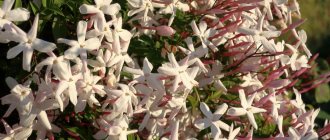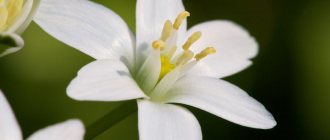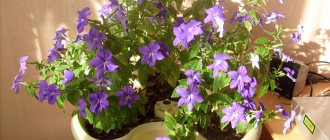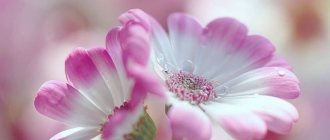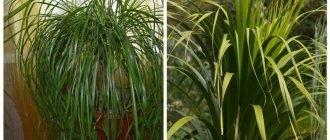Jasmine grows quickly: a rooted cutting planted in the ground can reach the height of an adult plant - 2 meters in almost a year. Jasmine often grows by wrapping its strong stem around a support. The time and duration of flowering, the color and shape of flowers depend on the type of plant. What they have in common is an elegant appearance and a unique sweetish aroma.
| Growing quickly. |
| Jasmine blooms from January to March. |
| The plant requires special conditions. |
| Perennial. |
Useful properties of jasmine
Only multi-flowered (medicinal) jasmine with simple white flowers is endowed with healing properties. Every part of the plant contains useful substances. Based on them, drugs are produced to strengthen the nervous system, normalize blood pressure, and treat the liver. Jasmine in the form of infusions, decoctions, and tea has analgesic, antiallergic, sedative and antiseptic effects. Restores hormonal balance in the body.
Green tea with jasmine relieves nervous tension, increases performance, and improves mood. Jasmine leaves are used to reduce body temperature. A decoction of flowers increases lactation, and a decoction of leaves stops it. Hot compresses are used for skin ulcers.
Jasmine essential oil, used in perfumery, is very expensive all over the world, because about 7 million flowers are consumed to produce 1 liter of oil. The smell of jasmine improves mental activity, invigorates and creates an atmosphere of harmony. Inhalations with oil are carried out for laryngitis.
Popular beliefs
In many countries there is a belief that stephanotis must be grown in the garden of every home. According to Tatar legend, everyone entering heaven is asked whether they have grown jasmine in their home area. But in general, the signs about stephanotis are very contradictory, so each person must decide for himself what to believe.
About homemade stephanotis
- Indoor jasmine is considered the patron saint of women, preserving feminine charms, beauty, youth and charm. If a single lady wants to meet her chosen one, she definitely needs to have a stephanotis in her house. The plant will attract love and harmonious relationships into her life.
- The flower has a different effect on men, weakening their energy. Being in the same room with jasmine, representatives of the stronger sex feel uncomfortable and try to leave the room as soon as possible.
- Indoor jasmine is also endowed with the ability to neutralize negative energy, relieve tension, and extinguish quarrels and conflicts.
Very often, jasmine is added to the bride’s bouquet so that the newlyweds’ life together is long, happy and full of romance.
Superstitions when growing on site
Eastern traditions define jasmine as an exclusively female flower . That is why there is an opinion that every lady should grow stephanotis in her garden. Jasmine scent is associated with feminine attractiveness and love affairs. According to signs, the owner of jasmine will never remain without the attention of the opposite sex.
If a woman does not want to acquire a large number of fans, she should refrain from growing jasmine on her plot.
Christian culture gives stephanotis only positive properties, the ability to attract happiness, luck, stability and warmth to its owners.
An important sign is that you should never break jasmine branches, give them in a bouquet or keep them in a vase at home. Otherwise, the person who harmed the plant will be haunted by disagreements and enmity with loved ones.
Caring for jasmine at home (briefly)
When jasmine at home receives sufficient nutrition, water, light and warmth, it develops harmoniously and responds to care with a healthy appearance and lush flowering. To make the flower feel comfortable, conditions suitable for it are created in the room:
| Temperature | In winter – up to + 13°C (at higher temperatures the flowers may not open); the minimum temperature that jasmine can withstand is + 8°C; spring – autumn – + 15 – 23°C; must be protected from drafts and sudden changes in temperature. |
| Air humidity | Increased; regularly spray the leaves without getting on the flowers; It is useful to keep the pot on a tray with moistened expanded clay. |
| Lighting | Bright diffused light is needed; window facing southeast or southwest; on the window on the south side the bush is shaded at noon, on the north side - lighting is installed. |
| Watering | During growth in summer - after 2 days, so that the soil remains moist; In autumn, watering is reduced; in winter - once every 7 days, the soil should dry out in between waterings. |
| Priming | Good drainage is needed; You can independently prepare a soil mixture from equal doses of leaf soil, perlite or sand, humus and a double dose of turf soil. |
| Feeding and fertilizer | Liquid diluted fertilizers during the growing season 2 times every 30 days; in autumn - once a month; In winter, feeding is stopped. |
| Transfer | Young bushes - every year after flowering, adults - once every 2.5 years; They bloom better in cramped containers. |
| Reproduction | Apical cuttings with several buds. |
When performing all the traditional flower care procedures, you need to know that there are specifics to growing jasmine. After flowering, the regrown shoots are cut by 2/3. The bush needs to be ventilated periodically. Jasmine is grown using support.
Cultivation and care activities
Caring for indoor jasmine is not difficult, so even a novice gardener can grow a beautiful and flowering plant. Caring for indoor jasmine is divided into two periods:
After planting or transplanting, the flower does not require special care. During this period, it is necessary to monitor soil moisture and regularly spray the leaves with clean water. Fertilizers are applied no earlier than after 2 months. Care for growing an adult plant consists of:
Jasmine should be fed from the beginning of spring to the beginning of autumn. Fertilizers are applied every two weeks. With this feeding, organic and mineral mixtures are alternately used. In autumn, the frequency of feeding is once a month. During this period, complex fertilizers are used. In winter, jasmine is not fed.
Mulching the top layer of soil in a flowerpot allows you to slow down the evaporation of moisture and prevent the soil ball from drying out. Mulching can also significantly reduce the amount of watering. Wood shavings, decorative shells and stones are used as mulch.
Pruning jasmine stimulates the growth of new branches, which makes the above-ground part of the flower thicker. It is held annually, in the last ten days of February or the first ten days of March. Weak stems are shortened by half, strong stems are cut by a third. Short young branches are selectively pinched. Jasmine is formed in the shape of a vine entwining the support.
As a support, use ready-made metal or plastic semicircles or make them yourself. The stems are secured with twine. The main rule for caring for indoor jasmine is timeliness.
With insufficient care, the plant loses its visual appeal, weakens and can be affected by pests. Indoor jasmine is an unpretentious plant and does not require special growing conditions. With its help you can not only decorate the room, but also fill it with a unique fresh aroma.
Source
Caring for jasmine at home. Details
Growing homemade jasmine is not an easy task. A beautifully flowering plant is sensitive to any change in usual conditions. The environment in which the bush will grow must be stable. The florist must carefully note all the nuances of the plant’s contents and quickly respond to their changes, only then the jasmine will bloom perfectly.
Jasmine blossom
The beautiful long-lasting flowering of the plant is the result of careful care for it. Jasmine blossoming is a phenomenon that enchants with the beauty of its flowers and unique aroma. Dark green, perfectly oval leaves with pointed tips set off the flowers, which are single or collected in racemes. The color palette of flowers is varied. Although snow-white and cream shades are traditionally considered classic, jasmine petals can be colored in different tones of pink and yellow.
The shape of simple or double flowers is also varied. Most often they resemble stars. There are types of jasmine with flowers similar to peony or rose. Flowering occurs in different species at different times. Typically, indoor species bloom within 3 weeks if the jasmine has rested well in a cool room before that. There are types of jasmine that do not have flowers.
Temperature
Maintaining a certain temperature regime is important for the plant to develop properly. Jasmine at home will bloom wildly if it spends the winter in a cool place. At temperatures above + 13°C, its flowers may not open.
To maintain the temperature at this level, the room is often ventilated. The rest of the time, jasmine will feel comfortable at + 15 - 23°C. In summer, the plant is taken out into the garden or onto the balcony.
It is important to avoid sudden changes in temperature and protect the flower from drafts.
Spraying jasmine
In a room with dry air, jasmine convulsively squeezes its beautiful glossy leaves. Low humidity causes plant diseases, disrupts flowering, and provokes pest invasion. A good way to increase the level of air humidity is to spray the leaves with settled lukewarm water.
You need to spray carefully, trying not to get water on the flowers. The procedure is carried out throughout the year, excluding winter. After spraying, jasmine is protected from bright sun to avoid burning the leaves. To enhance the effect, the flower is placed in a tray with moistened expanded clay.
Lighting
Sufficient lighting is the key to the development of a healthy and beautiful plant. A jasmine flower at home needs bright, diffused light.
Due to lack of light, the bush will stop growing, lose its decorative effect, stretch out and will not bloom. When there is too much bright light, the plant can get leaf burn. If the lighting level increases, jasmine is gradually accustomed to it. It is best to place the flower on windows facing southeast or southwest. In the southern part of the house the bush is shaded at noon, and in the northern part additional lighting is installed.
In winter, a flower on vacation does not need lighting, and blooming jasmine grows at this time under fluorescent or phytolamps.
Watering jasmine
For jasmine to bloom beautifully, home care requires proper watering. In summer it is important that the soil remains moist, so water every 2 days. In autumn, water less often. In winter, make sure that the soil dries out a little between waterings; to do this, water it a maximum of 2 times every 7 days.
If jasmine blooms in winter, water it once every 5 days. After flowering, watering is reduced. They try not to over-moisten the bush, so as not to cause death due to rotting of the roots. The soil should be moist, but not wet. For irrigation, use soft, lukewarm water. Jasmine responds well to settled rainwater. Twice every 30 days, the water is acidified with citric acid (3 - 5 crystals or a few drops of lemon juice per 1 liter of water). This will improve flowering and keep the flower in good shape. After watering, the soil is mulched with coconut substrate or sphagnum.
Jasmine pot
It is important to choose the right pot for jasmine, then it can fully develop. The diameter of the new container should exceed the diameter of the previous one by no more than 3 cm. The height of the pot also increases. In this case, the roots of the plant will be conveniently located, and the optimal amount of soil can be poured into the container.
Jasmine develops well in cramped conditions, and a large amount of “extra” soil in the pot will cause it to sour and become heavier. Under these conditions, the plant will “fatten”, growing leaves and root systems to the detriment of flowering.
There should be a hole at the bottom of the pot for drainage.
Soil for jasmine
The soil for jasmine needs to be well-drained and loose. Jasmine prefers soil with a neutral acidity level (pH approximately 6 - 7). A universal substrate for houseplants is well suited, to which you can add a little coniferous soil.
You can make the soil mixture yourself from leaf soil, peat, greenhouse soil, humus, taken in equal parts, with the addition of ½ part sand.
Feeding and fertilizer
Feeding and fertilizer are very important for jasmine during growth and flowering. Once every 10 days, use liquid mineral fertilizer for indoor plants, diluted 2 times. Once every 30 days, apply diluted organic fertilizers.
After flowering ends, feeding is suspended until the next flowering.
All fertilizers are applied after watering, preferably in the evening.
Jasmine transplant
Replanting jasmine is a natural process necessary for the flower to develop optimally. Young bushes need to be replanted annually, adults - less often, once every 3 years. Having chosen a pot of the appropriate size and prepared the soil, the jasmine is carefully replanted (transferred).
We must try not to damage the roots. If possible, do not destroy the lump of old soil, sprinkling it with new soil. Be sure to pour a thick layer of broken brick or expanded clay onto the bottom of the pot for drainage. The transplanted jasmine is watered, mulched and left in a shaded place for several days. The procedure is carried out after flowering and cutting the jasmine.
Trimming
Pruning is needed to rejuvenate and form the crown of the bush. Jasmine loves a haircut, which is carried out annually before the start of the growing season. Species that bloom in winter are pruned in the fall, when the intensive growth phase begins. There are fast-growing types of jasmine. They are pruned twice: after a period of active growth and before flowering begins.
Using clean, sharp scissors or pruning shears, carefully cut the side shoots in half. This will cause lush flowering and stop the growth of shoots. Weak, skinny branches, as well as branches with deformed small leaves, are removed completely. When a young bush has 7–8 pairs of leaves, pinch the tops of the shoots to encourage branching.
Autumn and winter
During the cold season, you need to water flowers with extreme caution, since the air outside and indoors can be quite humid. Under no circumstances should excessive access of water be allowed into the pot with the plant; this will have a detrimental effect on the root system and the condition of the jasmine.
Quality also needs to be paid attention to, the water should be soft and settled. Too cold water will cause the substrate to cool, and the flower will not tolerate this; the temperature should be at least room temperature.
Although care may seem difficult, it is still worth a try, because the beautiful buds and aroma will be an excellent addition to any interior. And voluminous compositions will greatly decorate every room and the most inconspicuous corner of the house.
Jasmine propagation
Jasmine is propagated vegetatively - by cuttings and layering.
Propagation of jasmine by cuttings
Propagation by cuttings is a popular way to obtain a new jasmine bush.
- In spring, cuttings are cut from mature stems, in summer - from young shoots. They do this when the bush does not bloom.
- Cuttings up to 15 cm long, with at least 3 internodes, are cut with a sharp knife along the oblique.
- They are kept in a solution of a root growth stimulator for several hours, dried and dusted with charcoal.
- Place in a damp peat-sand mixture, deepening it to 2.5 cm.
- Cover with polyethylene, making holes in it for ventilation.
- Leave at + 20°C, periodically ventilating and watering. After about 30 days, roots appear.
- The seedlings are placed in separate small pots. You can root in water by adding a little crushed coal to it.
Reproduction of jasmine by layering
Reproduction by layering is easy and painless for the plant. If there is enough space in the pot where jasmine grows, dig in a shoot of the plant, scraping off the bark and treating this place with a root growth stimulator. If there is not enough space in the pot, another container filled with soil is placed next to it, and the cuttings are buried in it. When rooting occurs, the cuttings are cut from the mother plant and replanted.
Both propagation options are simple. When they are used, all varietal characteristics of the mother plant are preserved.
Is it possible to keep the plant in the house?
Conflicting superstitions about jasmine cause gardeners to doubt whether it is worth growing a beautiful but demanding flower in the home.
The benefits of an indoor flower
Most signs about jasmine are good and characterize the flower only on the positive side.
- It is believed that the flower cleanses space from negative influences, negative energy, and fills it with calm and serenity. Stephanotis is able to stop conflicts and disagreements at the moment of their origin.
- Eastern signs describe indoor jasmine as the guardian of eternal love, strong marriage ties, and warm family relationships. Thanks to a flower located in the house, spouses will be able to maintain passion and interest in each other for many years.
- According to popular belief, a single woman should have stephanotis in her home to find happiness in her personal life. In addition, it is recommended to keep jasmine in the house for people who dream of healthy offspring.
- For people pursuing a career, the plant will become a faithful assistant in making decisions in difficult situations and finding answers to important questions.
How can it be dangerous?
Indoor jasmine is a climbing and creeping plant that is considered a muzhegon, that is, capable of expelling men from the house. According to one of the signs, stephanotis perceives a man as a competitor and strives to drive him out of its territory . Many fear that, in fact, representatives of the stronger sex are fleeing the house where jasmine grows.
Diseases and pests
With the slightest mistakes in care, jasmine becomes very vulnerable. It is attacked by diseases and pests.
Diseases manifest themselves in deterioration of the appearance of the bush:
- Jasmine leaves turn black – the plant is cold (move to a warm place);
- Jasmine leaves dry out - lack of moisture or too bright light (water, shade);
- flower buds do not open - there is not enough light (move to a brighter place);
- jasmine leaves turn brown - too hot and dry (spray, place in a tray with wet expanded clay);
- compression, curling, drying and flying of leaves - direct sunlight, lack of moisture, dry air (shade, spray and water the plant);
- leaves dry and stems wither - very bright lighting (shade);
- dropping leaves - little light, insufficient or excessive watering, draft, dry air (move to a lighted place protected from drafts, adjust watering, spray);
- shoots dry out - alkalization of the soil when watering with fresh water (water with acidified water);
- The tips of leaves and young shoots dry out - drying out of the soil, very dry air (water, spray).
When the rules for caring for jasmine are violated, it is attacked by pests: aphids, leaf weevils, whiteflies, spider mites, scale insects, and mealybugs. Before taking up insecticides, use proven folk methods (spray with decoctions of tobacco, calendula and celandine, treat with green soap): jasmine is a delicate plant and may react poorly to strong drugs.
Fluid requirement
At each stage of growth, jasmine will require different amounts of water, these points will be very important for maximum effect. The most intense and abundant procedures occur in spring and summer; at this time of year, owners are very vigilant and scrupulous in irrigating leaves and soil.
You should start watering the soil only when a drying crust begins to appear on it; this indicator has never failed. In this case, the soil will not be too wet and things will not dry out too much. A stable environment can only be achieved through constant monitoring of the humidity level.
Types of home jasmine with photos and names
There are about 300 types of jasmine. They have different colors and flower shapes, stem lengths. Some species, decorated with small, pretty leaves, do not bloom. They are used in landscape design. Only some species are grown at home.
Royal jasmine (Jasminum rex)
The most popular type of homemade jasmine. The powerful creeping stem is decorated with large (up to 7 cm in diameter) white, odorless flowers. Blooms luxuriantly, usually in winter. A very decorative variety.
Multifloral jasmine (Jasminum polyanthum)
Evergreen vine with thin branches. Snow-white star-shaped flowers with a delicate aroma bloom from soft pink buds. There are about 20 buds in the inflorescence. Strong pleasant aroma. Spring blooms, although rare flowers appear throughout the year. Grown on a support.
Jasmine sambac (Jasminum sambac)
A climbing evergreen shrub with white star-shaped flowers that have a pleasant delicate aroma. It blooms magnificently and for a long time - from May to October. Does not produce seeds. Can overwinter at normal room temperature.
Primrose jasmine (Jasminum primulinum)
A fast-growing shrub with thin branches and semi-double large yellow flowers. The flowers are odorless, similar to primrose flowers (primrose). Grows with support. Flowering - from late spring to early summer.
The greatest joy of a florist is to see how the plant he grew from a small seed or cutting has bloomed: it means that his worries have been justified. Jasmine is a capricious plant that knows its worth. It will not bloom in hastily created conditions. If you try and put your soul into the plant, the bush will be decorated with elegant, delicate flowers with a charming aroma.
